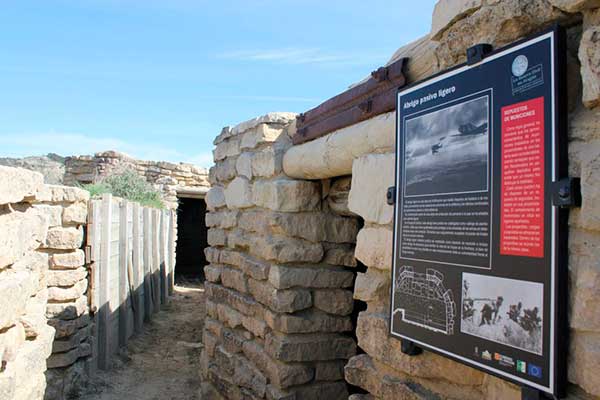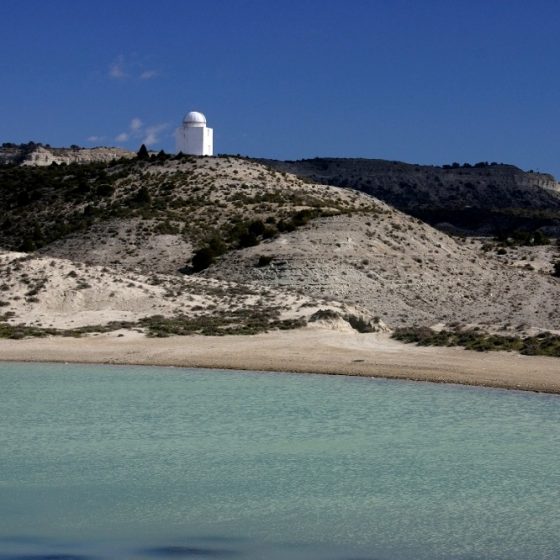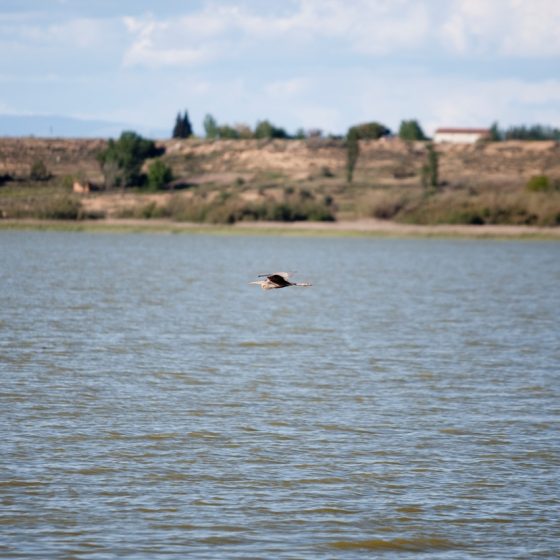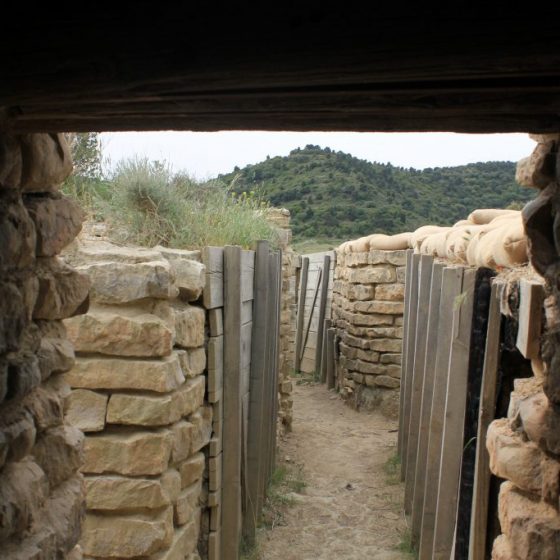THE EXPERIENCE
The vestiges of the war recuperated in Los Monegros became a pioneer project in Spain in 2006. Today they conform the first route of democratic memory of Aragon and it supposes a cultural tourism route that brings us closer to the most tragic and recent history of our history.
A walk that overwhelms, excites and makes us understand the reality of the combatants in the Spanish Civil War in their own scenario. To go through the trenches, casemates, bunkers and parapets that Orwell quotes in his work “Homage to Catalonia” and that shows us the harshness of the Aragon front in the Sierra de Alcubierre and Los Monegros.
Where does it take place?
Los Monegros, in the surroundings of the Sierra de Alcubierre.
Remember
- You are going to a desert area
- Bring hydration and protect yourself from the sun and air.
- Wear comfortable clothes and shoes
RESERVAS Y CONTACTO
CENTRO DE INTERPRETACIÓN Y VESTIGIOS DE LA GUERRA CIVIL EN ARAGÓN
Plaza Zaragoza s/n
Robres (Huesca)
974 570 090
turismo@monegros.net
Trenches Route Orwell, the Three Huegas and Santa Quiteria
Orwell Route – Monte Irazo Position (Alcubierre)
The war line crossed the region of the Monegros through the Sierra de Alcubierre, natural limit between the provinces of Huesca and Zaragoza, propitiating the construction of military equipment and elements of civil defense in both foothills and in the localities of the surroundings.
On the A-129 road, from Leciñena to Alcubierre, at Km. 34.6 you will find the road that leads to the Monte Irazo position.
The British writer George Orwell (1903-1950), isolated with the militias of the POUM (Partido Obrero de Unificación Marxista), was sent to the Sierra de Alcubierre in the first days of January 1937. For three weeks he fought in Monte Pucero and later in this position Monte Irazo, until February 16.
Orwell left a testimony of his passage through Monegrin lands in his testimonial work Homage to Catalonia. In the tour through the trenches we can observe barbed wire fences, communication branches, shelters, shooters’ wells and bivouacs. All the elements common to settlement.
The Three Huegas (Leciñena)
At Km. 33.5 of the A-129, you can access a complete rehabilitated area that served as a bivouac or shelter for the insurgent troops. You can also visit the San Simón hill. It is located in the area known as Las Tres Huegas, (limit or separation) since the municipalities of Robres, Alcubierre and Leciñena converge at these heights.
The monument to the fallen was raised in the early forties in the Puig Ladrón mountain (699m), to remember the battles carried out by the rebel army and the Falange. The feat of San Simón, also remembered with a monolith in the bivouac area, in commemoration of this event, an annual concentration is held around the anniversary date.
In the itinerary of the bivouac area (rest shelter) we find wells, kitchen areas, cisterns, cave shelter, observatory area platform, trench and communication branches.
Santa Quiteria Position (Tardienta)
Located next to the hermitage of Santa Quiteria (533 m) to the north of the Sierra de Alcubierre, it is a geostrategic enclave in the conformation of the Aragonese front, where some of the most breathtaking pages of the war took place, from the beginning of the war until Franco’s advance towards the Mediterranean in March 1938. Its dominance provided a privileged observatory and an unbeatable scenario both in defense and in the planning of the attack.
The rehabilitation work of this trench has focused on the recovery of the observatory-well built with stone materials from the ground, and the excavation of a defensive settlement with all the elements that are common to it: communication branches, single and double shooter wells, grenade launcher and light machine gun settlements, as well as a light shelter that served for the command and possible storage of ammunition, weapons and other instruments necessary for the use of soldiers and defense of the fortifications.
Lanaja Bunker
This solid machine gun emplacement is located on the Cantalobos road, 200 meters from the A-129 detour. It was designed and built by Republican engineers and soldiers, since the town of Lanaja remained in territory loyal to the Government of the Republic until the fall of the Aragon front in March 1938.
Imposing structure of reinforced concrete protected as a fort and observatory at an angle of 180º. The environment of the bunker, constituted a defensive set today practically nonexistent, framed in the so-called “Lennin Line” of defense.
Reconstructed a section of trench or branch of communication excavated for the service of suppliers, servants and ammunition of the machines, allows to show, a very approximate image of the strategy of the position.
Monegrillo Air Raid Shelters
Monegrillo has one of the best preserved air-raid shelters of the Monegros Front route: the “Cueva del Castillo” air-raid shelter.
The “Cueva del Castillo” air-raid shelter served as a shelter for the inhabitants of Monegrillo during the bombings of the Spanish Civil War. The village had been taken on August 11, 1936 without firing a single shot by anarchist militiamen of the Durruti column.
During eighteen months the population had to seek refuge on more than forty occasions from enemy aircraft, coming from the nearby airfield of Zaragoza. Attacks with French, German and Italian airplanes that served as a training for the Second World War.
The neighbors built this shelter, helped by expert miners enlisted in the anarchist militias. They drilled into the rock of the hill where a watchtower once stood and shaped one of the most secure defensive systems called “mine gallery shelter”.
Recently restored and adapted for visits, it offers a spectacular tour of its interior through a themed recreation with lighting, speech and sound effects, which allows you to have a very close experience to what the inhabitants of Monegrillo had during the bombings in the Civil War.
The shelter also offers the possibility of free visits and a children’s program specially designed for primary education.
Reservations and appointment / Contact
Entrance fee: 1 euro. 50% of the total amount collected goes to a charitable cause, the United Nations High Commissioner for Refugees – UNHCR – Spanish Committee, in order to help refugees, displaced persons and current wars. In this case to UNHCR projects in Yemen, a country punished by more than 5 years of war.
Visit: Duration of visit 20-30 minutes. Maximum 6 people per group.
By Phone: 976 16 31 31 01
By Mail: monegrillo@dpz.es
Alas Rojas Sariñena- Albalatillo Aerodrome
In the road HU-V-8.301, Sariñena- Albalatillo, and very close to this last locality, there are remains of the most important airfield of the Republic in the Aragonese front.
In process of recovery, work has been done on the left side at the Saso fountain, originally from the airfield, an anti-aircraft defense point or small powder magazine. On the right side of the road, a gunner’s post and two other machine gun nest posts have been adapted. Also, two entrances to the powder magazine have been cleaned.
Informative panels help us to understand the first months of the aviation during the war.
Interpretation Center of the Civil War in Aragon Robres
The Interpretation Center of the Civil War in Aragon, located in Robres, exhibits original materials, press, documents and audiovisuals to contextualize the period 1931-1975. A museum of reference, opened in 2006, that is the central axis of the visit to the abovementioned vestiges.
VISITING HOURS
Saturdays: from 11:00h to 14:00h and from 16:30h to 18:30h.
Sundays and holidays: from 11:00h to 14:00h.
July and August: Saturdays, Sundays and holidays, from 11:00h to 14:00h.
TICKET PRICES:
General: 2 euros
Senior citizens and groups (more than 10 people): 1.5 euros.
For guided visits to the trenches and the center, please call 974 570 090.






